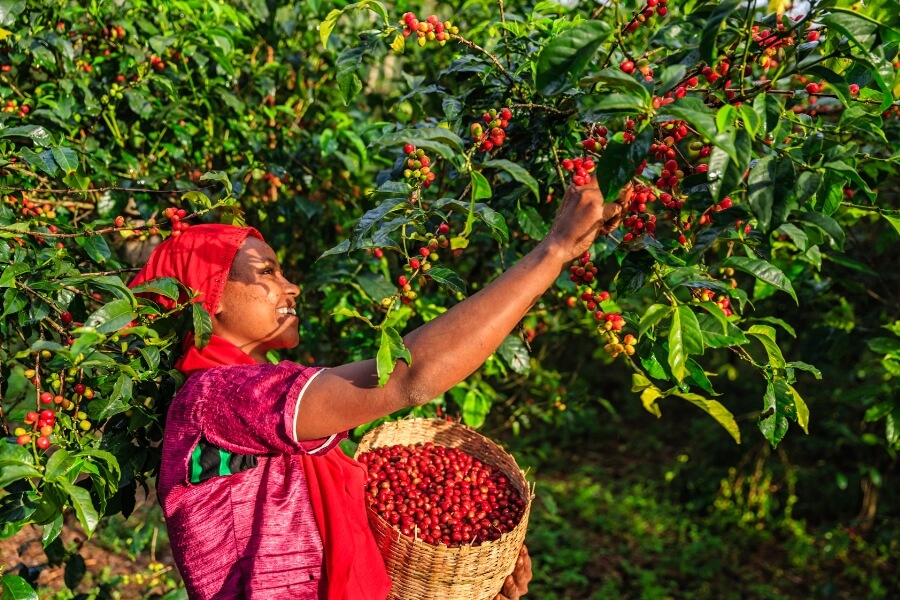After the coffee tree flowers and the fruit ripens, the coffee beans begin their adventure until they reach your cup. Today we will focus on how to harvest them. Do you know how coffee is harvested? Here we explain it to you!
Coffee harvesting
Coffee harvesting is carried out by the coffee growers, the coffee growers.
When we think of coffee plantations, huge tree plantations often come to mind, but in reality, 70% of coffee plantations are operated by small family businesses, with cultivation plots of less than 10 hectares, and in fact, a large proportion of them are less than 5 hectares.
Once the ripening times have passed, the harvesting seasons do not usually coincide between different countries, as they vary according to the climate, the area, and even the altitude of the plantation. It also varies according to the proximity of the country to the tropics.
Coffee production involves many people, as almost all stages of coffee production require human labour and processes are difficult to mechanise.
So when is the coffee harvested?
The time of harvesting is determined by the colour of the cherries, which take on a reddish hue when they reach maturity.
The ripening times depend on the coffee variety, Arabica between 6 and 8 months after flowering and Robusta coffee between 9 and 11 months.
It is usual to produce one harvest per year, for example, in Brazil the harvest takes place between May and September. But in Colombia, they have two harvests, a more modest one between March and April, and the main harvest in the second half of the year. Then there are other territories such as Java (in Indonesia), where they are harvested three times a year.
The reddish colour of the cherry determines its degree of ripeness and indicates that harvesting can begin.
Cherry harvesting methods
There are different methods of harvesting cherries, each with its pros and cons. Here are the three main ones:
Grain by Grain or Picking
Picking" is a method that consists of selectively harvesting the cherries by hand, i.e. selecting and picking only those fruits that are ripe and healthy.
This means that, in a plantation where not all the coffee trees and cherries ripen at the same time, only those that are ripe are picked and those that are still green are left. In this way, in a second harvest at a later date, the ones that are progressively ripening will be harvested, thus extending the harvest.
The coffee grower makes sure that the cherries are picked at their perfect ripening point and takes care not to damage the buds on the branch under any circumstances. This is because, if the buds are damaged, they will be lost for the next harvest.
It is a very selective harvest and is used for high quality coffees. This method is often used in areas where coffee cherries do not ripen at the same time, where machinery cannot access or in high altitude harvests.
This system is the one that has always been traditionally used, the coffee growers usually carry a wicker basket tied around their waists, where they deposit the harvested cherries.
By milking, scraping or "stripping".
This method consists of threshing the whole branches from the inside to the outside in one go, regardless of the degree of ripeness of the cherries. It can be done either manually or by machine.
It is important to make sure that as many coffee cherries are ripe as possible, and this requires close observation of the plantation to decide the exact moment.
Its main advantage is that it reduces the harvesting time and the final cost, but on the other hand, both ripe red fruits and green fruits are harvested. This affects the final quality of the coffee and its acidity, as the presence of green berries will result in a more acidic coffee. To avoid this, it is usual to check after harvesting and remove any fruit that is too green.
Mechanical harvesting
In this case, machinery is used to harvest all the fruit; it is used in countries where the ripening of the fruit is more or less uniform.
It is an unusual method, as it generates a great deal of stress on the plant due to the vibration method used by the machinery. It also requires accessible land for the machines to enter, which rules out most shade planting.
There is also the disadvantage of harvesting cherries while they are still green, which have to be removed later.
With what you have learned and knowing all the hard work that goes into it, we hope that the next cup of coffee will be much more enjoyable and enjoyable for you.




